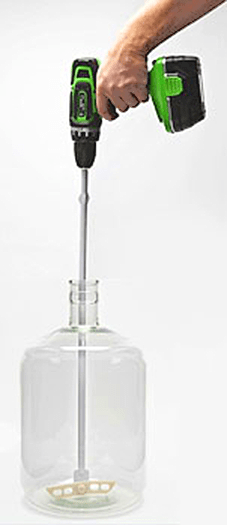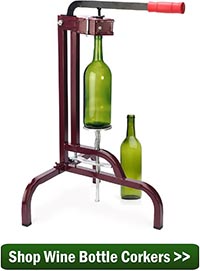 Thank you so much for all the information–it has been a lifesaver at times! My question is on degassing wine with a drill Mix-Stir in the carboy. How fast should I be using it with my drill? It seems like I just keep making more and more foam if I speed it up and I don’t know if that’s a good thing or not. It also takes forever. Should I slow the drill down? And when should I stop-is it okay to have just a few bubbles left? Thanks so much from a “Newbie”, and keep up the good work.
Thank you so much for all the information–it has been a lifesaver at times! My question is on degassing wine with a drill Mix-Stir in the carboy. How fast should I be using it with my drill? It seems like I just keep making more and more foam if I speed it up and I don’t know if that’s a good thing or not. It also takes forever. Should I slow the drill down? And when should I stop-is it okay to have just a few bubbles left? Thanks so much from a “Newbie”, and keep up the good work.
Name: Eileen M.
State: Florida
—–
Hello Eileen,
When degassing wine the a drill mixer, you want to run the drill as fast a possible. The only thing that should be slowing you down is the foam that is wanting to come up and out of the wine. Like pouring a glass of hot soda pop over ice, this may require a little patience on your part. But other than that go as fast as you can. No reason to keep things slow. Degassing the wine quickly will not hurt the wine in any way.
Having said this, the one thing you definitely do not want to do when degassing with a drill is splash the wine. Splashing is different than mixing the wine. When the Degassing/Mixing Paddle is submerged into the wine it is only agitating the wine within itself. When you are splashing the wine you are disrupting the surface of the wine.
Splashing the wine can allow air to saturate into the wine. This would be a bad thing since air in the wine will promote wine oxidation. Splashing is not so much an issue when you are first starting the degassing process because so much CO2 gas is coming off the wine that air can not saturate. But it does become a consideration as you finish up degassing the wine with a drill mixer.
As to your question about how long you should be degassing the wine or how far you should go, you want to get it to a point where there is only a small amount of foam being produce. Don’t worry about getting all the gas, just get to a point where it’s relatively hard to make foam. If a remnant amount of CO2 gas is still in the wine, that’s okay. This amount will have opportunities to leave during racking and bottling.
 Just realize that degassing wine with a drill mixer is a safe and efficient way to go about it. Just get the paddles in the wine before spinning it, and you’ll have no issues whatsoever.
Just realize that degassing wine with a drill mixer is a safe and efficient way to go about it. Just get the paddles in the wine before spinning it, and you’ll have no issues whatsoever.
Happy Winemaking,
Ed Kraus
—–
Ed Kraus is a 3rd generation home brewer/winemaker and has been an owner of E. C. Kraus since 1999. He has been helping individuals make better wine and beer for over 25 years.

HI,
when should degassing take place? right after the primary fermentation?
I did this with a batch of Merlot and I think it lost its smell and taste. What are the perils of degassing with a drill?
Thanks
Pablo, degassing is something that is typically done after the wine has completely cleared and before bottling. Anytime in there is fine. It is possible that the aroma or bouquet of a wine will diminished after degassing, however this is only temporary. Flavor will usually become flat and lifeless as well. This is because of a wine phenomenon known as "bottle shock". It also happens further right after bottling the wine. Putting the wine through such activities will affect the wine in such ways. The wine does recover from this though. It is just a matter of time. Usually the first 30 days in the bottle will show great improvements and the overcoming from bottle shock. Here’s more information:
What On Earth Is Bottle Shock
http://blog.eckraus.com/wine-making-tricks-and-tips/what-on-earth-is-bottle-shock
Do you have to degass? We make our wine from local fruits and have never degassed our wines. Friends that always use the kits, always degass.
Thank you for your input.
Debbie, the wine does need to be free CO2 before bottling. When making wine with fresh produce, the wine could sit around long enough to degas itself naturally. The wine kits always require degassing because they are normally bottled much sooner than a wine made from fresh produce. The article posted below will go into more detail about degassing.
Degassing Wine
http://www.eckraus.com/blog/degassing-homemade-wine
I’ve recently bought an automotive “Mityvac MITMV8500” pump/vacuum unit from Amazon after4 having read applicable reviews on wine-making sites, and this I think makes life much simpler.
I attached a food grade tube to the pump (vacuum port), then attached the other end to a bored bung, fit to demijohn, pump up the vacuum to approx 20kPa then simply wait: the bubbles rise to the surface. If the vacuum reduces then pump again (to say 20) and wait. I found I could simply set this up and leave it. Benefits: no wine oxidation takes place, no sitting there holding a drill and paddle forever, clean & simple. Downside = cost, I paid 60GBP for a quality item (and it is), also knowing I could use it for my car or motorbike later.
Any views on this method?
Bill, using the vacuum pump is a fine way to degas your wine, many of our customer do the same. The only thing that you said that you might want to re-think is going off an leaving the pump on the wine and running. You could remove some of the aroma of the wine if left too long.
I read somewhere that when using a drill and whip method of degassing a wine, you shouldn’t spin so fast that you create a vortex (inverted funnel) in the wine/must because it introduces more oxygen into the wine. Is this true?
Ron, you do want to be careful not to introduce oxygen into the wine. For example, the directions for our de-gassing paddle is to run it on low/forward speed for 10 seconds at a time and you should only need to do so about 3 times to degas the wine.
After the wine stops fermenting I add Bentonite and then use the paddle for de-gassing. wait 2 or 3 days then bottle. Seems to work for me.
I am very new to wine making (first batch ever at the 2 week mark now) do you have a good article on how to sweeten a wine kit? Just incase its to dry I want to sweeten it a little but I don’t want to risk starting a fermentation again so is there a certain sweetener I can use that won’t react with any left over yeast I might have? Thanks for any help.
Joshua, below is the link to an article that will walk you through the process of sweetening your wine at bottling time.
How Do You Sweeten Wine at Bottling Time
http://www.eckraus.com/blog/how-do-you-sweeten-wine-at-bottling-time
Please advise. My husband used a paint auger to stir down cap. I think it may have negatively impacted the must.
I feel lots of oxygen was introduced this way.
Your input is much appreciated.
Beth, adding campden tablets can help remove excess oxygen, it does so by driving out any excessive oxygen that may be saturated into the wine. The sulfur gases from the Sodium Bisulfite displaces the oxygen.
DANGER!!! I had a disastrous experience degassing a Cabernet (wine kit). Transferred from primary to secondary at 15 days (SG 0.994). Let sit 24 hours under air lock. Added sulphite and post-tannin. Using whip to degas I started the drill and within seconds a volcanic eruption took place displacing wine everywhere. Imagine a gallon of red wine all over you room and equipment. Spent the whole day cleaning everything and had to paint the room due to stains on the walls. I have degassed other wine kits with a little foaming but nothing like this. Any idea what would have caused this reaction?
Wendall, actually, this can happen on occasion if there is a lot of gas trapped in the wine. You just need to be very careful when using the whip. I would do it for a couple of seconds and stop to let it settle before proceeding.